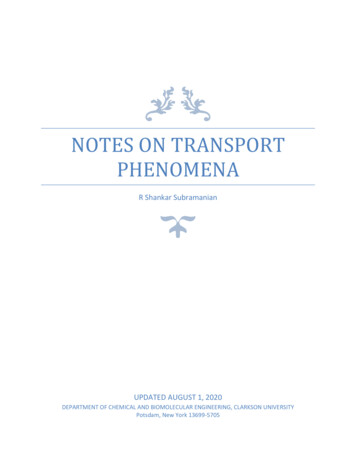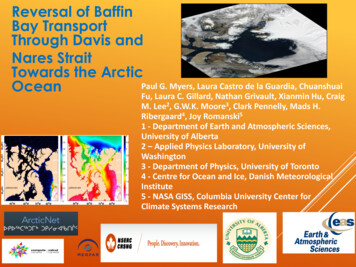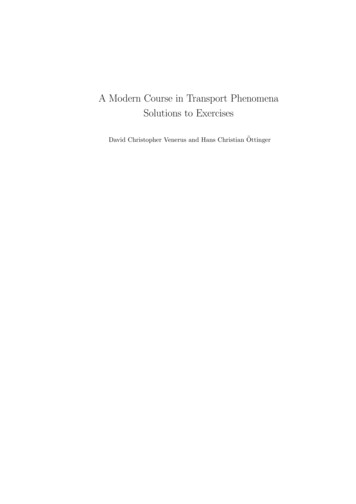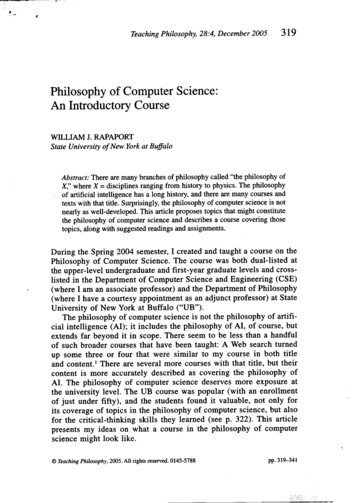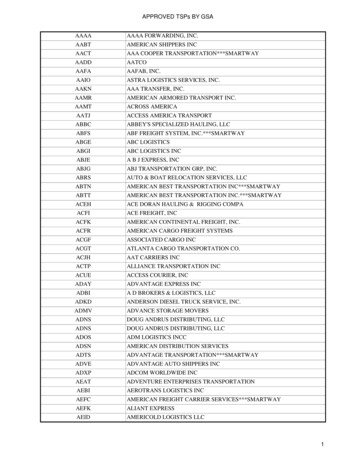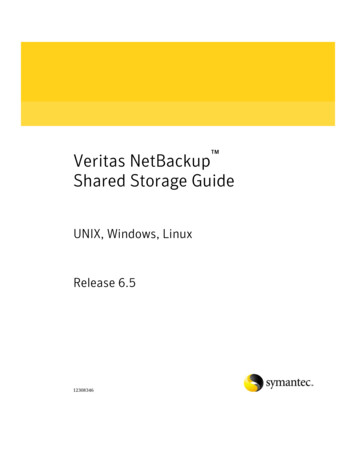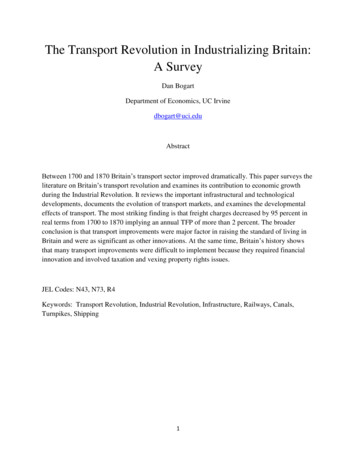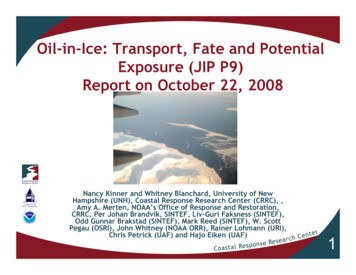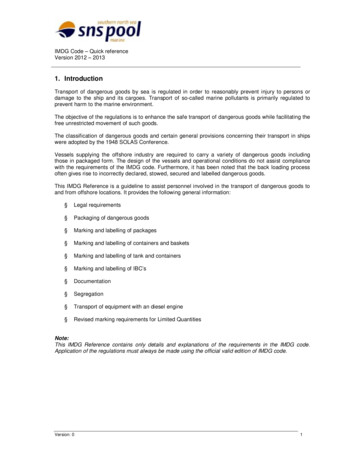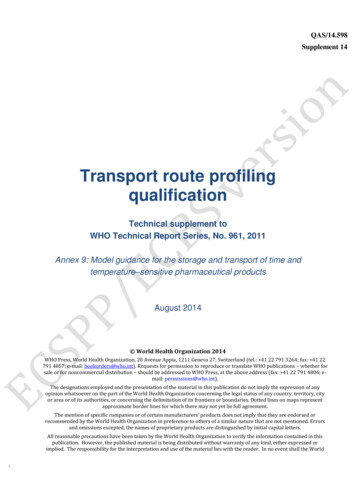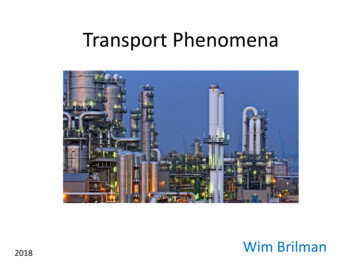
Transcription
Transport Phenomena2018Wim Brilman
Transport Phenomena: mainly deals with non-equilibrium situationsdifferences lead to transport of mass, momentum, energy the rate at which these processes proceed is a typical objectiveFluid dynamics further includes calculation of forces,momentum, velocity and -profiles and pressure dropIn this course :Fundamentals of transport of momentum, mass and energyare introduced and applied, aiming tounderstand and (quantitatively) describe phenomenaencountered in industrial/engineering practice and in daily life.The course is integrated with the course Numerical Methods, in which modeling skills(in MATLAB) are developed and applied to mentioned situations.
Typical Transport Phenomena Fluid Dynamics(stromingsleer)Heat transfer(warmte overdracht)Which mechanisms play a role ?How to describe the process ?How to solve the set of equations ?Check validity of answerMass transfer(stofoverdracht) set of equationsAnalytical and numerical solutions
PRACTICUMFluidDynamicsHeat &MassTransferPROJECTNumericalMethods
About Practicum and ProjectPracticum:* experimental study of heat or mass transfer processin an engineering-type set-up* well-defined set of experiments* team of 2 persons* guidance & preparation session with supervisor* small report (typical 10 pages; including prep. work)Project:* work in teams of 4 persons coach/consultant* project assignments: selection from list* challenging project: outcome is unknown* problem analysis group-work* making a plan and carry it out* experimental work* modeling* reporting (written report presentation)
EXAMPLE PROJECT: FOOD DRYING1heating3579 11 13 15 17 19 21For large scale production of fries, freshly cutpotatoes must be partly dried to increase thedry matter content from (around) 18% to(around) 25%. This is done in industrial dryers.For product quality a careful control of thedrying process is needed. A good model wouldcertainly be an assett here.Objectives are Make a model for an industrial dryer Determine the drying rate experimentallyand compare it with your model Geometry of potato friesEffect of relative humidityCombined heat and mass transferDesign your own experiments
After this module you should :* have knowledge of the basics of transport phenomena* be able to recognize transport processes and make link theory practice* be able to formulate the transport processes into a model description* be able to solve these problems numerically & analytically (where possible)
Module - ContentsST-Module 6Transport PhenomenaFluidDynamics50% , min. 5.5FTVProjectTransport PhenomenaFTV-praktpraktikumNumerical MethodsNum.methodsProject25% , min. 5.525% , min. 5.0
Module teamFluid DynamicsMartin van der Hoefm.a.vanderhoef@utwente.nlProjectenNumerical MethodsAnthony Thorntona.r.thornton@utwente.nlThomas BrouwerHeat and Mass TransferWim BrilmanMartin Bosd.w.f.brilman@utwente.nl(and more for the practical & project part)
Test planModule LevelTransportPhenomenaMin.gradeSUCCESS RATE: 50% PER EXAMAdministrative ade 5.5Weighfactor50% 6.0Num.MethodsProject 5.0 5.525%25%Subject levelSubjectFluidDynamicsHeat TransferHeat & Mass Process Eq.Comp. 1Comp. 2Comp. 3Comp. 4examWr. ExamWrittenexamExamExamExamAssignmentPr. PracticumReportProject –Exp.Report Project – Rep.[1]Method Min. Weighof testing grade factorWritten 4.0 40%Presentation 4.0 4.030%30%(pass) 4.0 4.0 4.0 5.5 5.5 5.510%30%30%30%25%25%50%Written Exam; Fluid dynamics (currently: i-FTV ).Written Exam; Steady state and instationary conduction, convective heat transport, radiation, in series-¶llel (part of current FTV exam)[3] Written Exam; Mass transfer (mass transfer models, diffusive and convective MT, coupled heat & mass, process equipment) (part of current FTV exam)[4] Matlab – Basics[5] Matlab – ODE Solver & Toolbox[6] Numerical Methods and Schemes[7] Matlab – Solving PDEs related to CFD and heat & mass transport[8] Includes a Practicum part (structured experimental work) and a more Advanced Project w.r.t. Transport Phenomena; including problem analysis,experimental work and modeling. Reporting includes written reports and oral presentation of the Advanced Project.[2]
TEAMWORKCHALLENGINGFluidPRACTICUMDynamics. .MODEL EXPERIMENTHeat &MassTransferNumericalMethodsPROJECT .THEORYAT WORKINTENSEEXHAUSTINGREWARDING
WHO SHOULD SUBSCRIBE ?ALL INTERESTED IN : CHEMICAL ENGINEERING – FOR MASTER STUDY TRANSPORT PHENOMENA(FLUID DYNAMICS, HEAT TRANSFER, AND MASS TRANSFER)(NL)AND NOT AFRAID TO SIGN UP FOR AN INTENSE COURSE !ST - M6 – TRANSPORT PHENOMENA
Thanks !More info ?Wim BrilmanMeander 222wim.brilman@utwente.nl
Transport Phenomena Min. grade Topic Min. grade Weigh factor Subject Method of testing Min. grade Weigh factor K6 Transport Phenomena 6.0 Theory 5.5 50% Fluid Dynamics Written exam 4.0 40% Heat Transfer Wr. Exam 4.0 30% Heat & Mass Process Eq. Written exam 4.0 30% Num. Methods 5.0 25% Comp. 1 Exam (pass) 10% Comp. 2 .
